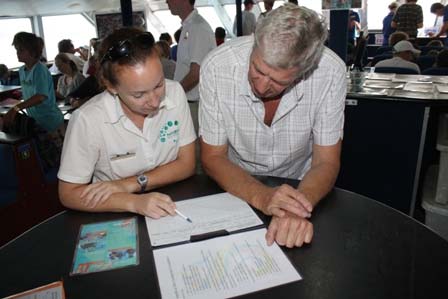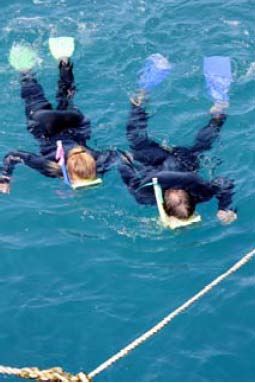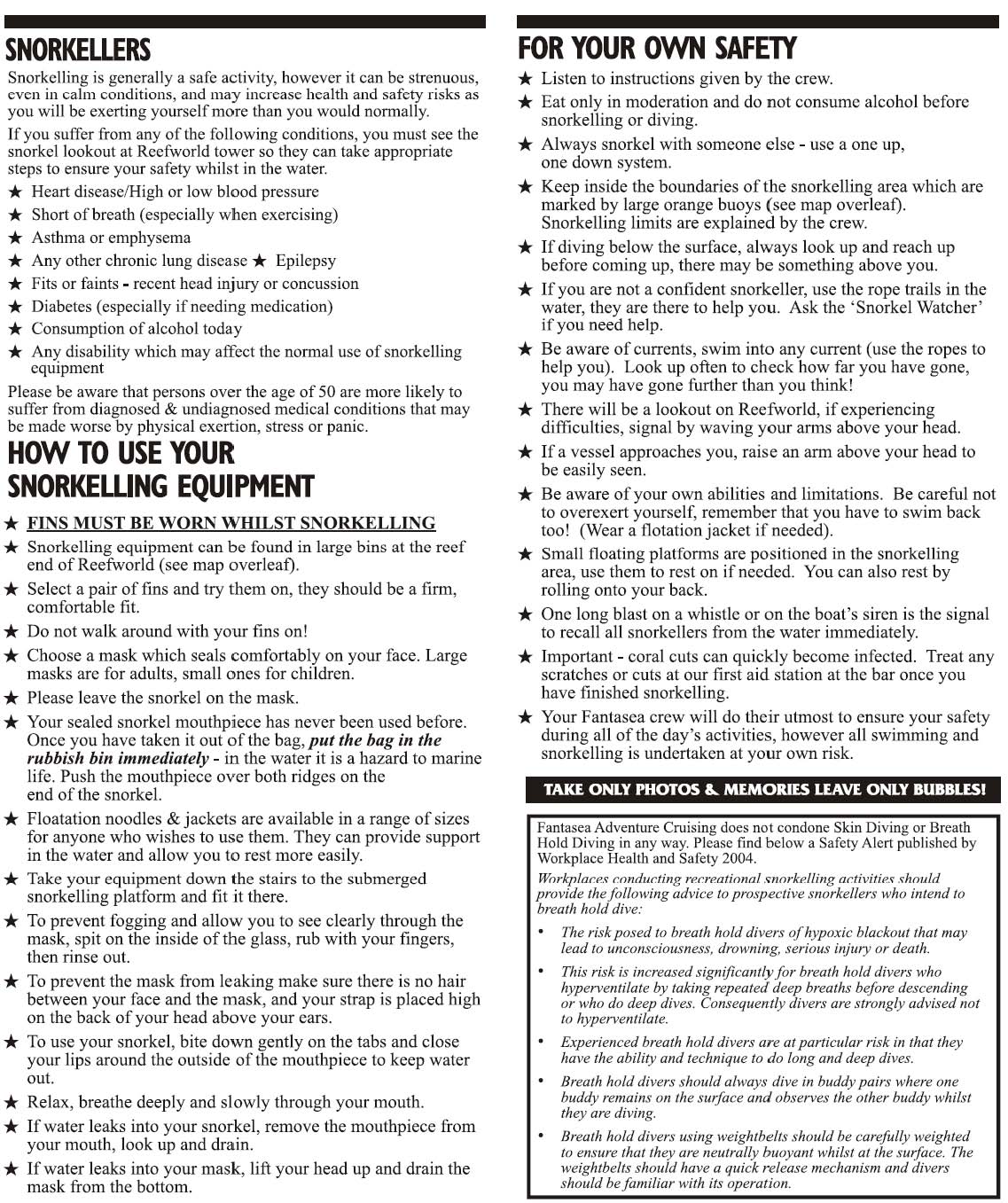Fantasea Adventure Cruising - a case study on managing the medical risks of snorkellers
Organisation
Fantasea Adventure Cruising is a Queensland owned adventure cruise and transport operator. They are part of the leading Australian marine transport group, Riverside Marine. Fantasea Adventure Cruising operates ferries between Whitsunday island destinations and delivers reef adventure tours for divers and snorkellers aboard a floating pontoon operating at Hardy Reef.
Fantasea Adventure Cruising employs around 107 staff between its Airlie Beach Island operations, pontoons and vessels.
Safety initiatives
A majority of Fantasea's passengers plan to snorkel when they go to the Great Barrier Reef. Snorkelling has potential health and safety risks associated with it, particularly for passengers who are first time participants, not strong swimmers or who may have medical or health problems.
Fantasea has implemented initiatives aimed at managing these risks through a systematic approach.
Key aims of the initiatives were to:
- improve the identification of snorkellers who may be medically at risk
- ensure the risks to snorkellers are individually assessed and recorded
- provide advice to snorkellers about ways in which to snorkel safely
- manage the risks to snorkellers by improving supervision, promoting the use of flotation devices, reducing exertion, and ensuring any rescues are prompt.
Some of the safety initiatives implemented by Fantasea include:
Welcome brochure
Upon boarding the vessel, passengers are given a 'welcome aboard' brochure containing advice about medical conditions which could be problematic when snorkelling. The brochure emphasises that passengers will not be prevented from snorkelling. The brochure is offered in eight languages to ensure non-English speakers still receive the important safety message (see appendix 1).
Medical risk assessment guidelines
During the reef trip, Fantasea crew members circulate among passengers explaining water conditions, tides and any potential hazards they may encounter. Passengers are asked about any medical conditions they may have, in a manner that encourages them to be honest when discussing any relevant issues.
Medical risk assessment guidelines have been developed for crew to assist them in providing advice and rating the risks from medical conditions (see appendix 2).
Snorkel demonstration
Prior to arrival at the snorkelling destination, a snorkel demonstration is conducted and passengers are requested for a third time to report all medical conditions to the supervisory staff before entering the water. Any medical information received is kept confidential and only the crew in rescue positions have access to it.
Risk assessment matrix
Any medical conditions reported by the passenger will be categorised either as low, medium or high risk. Environmental factors are then considered using a 'risk assessment matrix' (see appendix 3).

Risk control log
The risk management advice provided to the passenger is documented on the 'snorkelling risk control log' (see appendix 4) which is kept on the snorkelling platform.
The options for snorkelling advice that may be given are:
- wear a floatation device
- wear visible marking: pink tape on snorkel to identify higher risk, green tape to identify lower risk
- remain close to rope trails
- snorkel with a 'buddy'
- remain within the pink buoyed/restricted area – which requires less exertion and is closer to supervision and rescue
- go on a guided tour or have in water supervision from a competent crew member
- do not snorkel – this will only be used in severe or high risk case.

Role of crew and management
All crew who work with snorkellers receive training and assessment in their roles and how to implement this safety initiative, conducted by Fantasea's experienced inwater safety trainers.
Training involves theory sessions covering snorkel supervision procedures, rescue equipment uses, missing divers and snorkellers and risk assessing medical conditions. In-water training covers a fitness swim, self rescues, rescue aids (life rings, rescue tubes and rescue boards) and various scenarios.
The Fantasea management team pride themselves on the outstanding safety commitment the company has developed and refined over the years. They continue to support and motivate the crew through ongoing annual training and refresher courses to make sure crew can put every effort into the safety and well being of their co-workers and passengers.
Outcomes and benefits
Since implementing this new safety initiative, Fantasea crew have found passengers:
- are more receptive to safety information
- will comment positively on the individual attention given by crew and the greater sense of security created for the passengers who know their well-being is in safe hands.
This has proved particularly important at times throughout the year when Fantasea have more than 500 guests on the pontoon at any one time. At these times it is imperative that all crew know the importance of their role in maintaining the safety of the operation and ensuring a premium guest experience.
Case study contact
Heather Thatcher
Operations Coordinator and In-water Safety Officer
Fantasea Adventure Cruising
Ph: 0448 613 753
Email: heather@fantasea.com.au
Website: www.fantasea.com.au
Further information
For more information visit the Workplace Health and Safety Queensland website www.worksafe.qld.gov.au or call 1300 362 128.
Appendix 1 – Fantasea 'Welcome aboard' brochure (English version)

Appendix 2 – Fantasea medical risk assessment guidelines
Point to note
- Name of medical condition
- Are they currently taking any medication
- Is the condition stable
- When was their last fit/episode/attack
- Do they partake in regular exercise
- When was the last doctor check up
- Can they swim
- Have they previously snorkelled
Any medical risk assessments that fall into the high risk category must be booked on a complimentary snorkel tour. Any medications required are to be left at the tower prior to entering the water e.g. puffer, epipen, etc
All medical conditions (low, medium or high) must be recommended to:
- Wear a life jacket
- Snorkel with a buddy
- Wear a visible marker e.g. tape on snorkel
- Stay near the rope trails
General medical conditions the would be considered HIGH RISK
- Heart disease
- Epilepsy
- Fits, faints and seizures
- Diabetes (diabetics who lose consciousness, experience fits or are insulin dependant)
- Recent head injury
- Lung disease / Emphysema
- High or low blood pressure not controlled by medication
- Uncontrolled Asthma
Low, medium or high?
- As a minimum all guests reporting a medical condition assessed as being low, medium or high risk will be advised to wear a flotation devise, wear visible marking, remain close to the rope trails and to snorkel with a buddy.
- All guests who disclose a serious medical condition assessed as having a high risk will be asked to wear pink tape on their snorkel and restricted to the pink buoy area, thus restricting their level of exertion. Any guest who is high risk will be put on a complementary snorkel tour or accompanied in water by a rescue trained competent crew member. As with all snorkel tours, life rings must be used.
- Guests with a medical condition assessed as being a medium to low risk will be asked to wear a green tape on their snorkel to distinguish them to rescue crew, and will not be restricted.
- Any guest who has been refused a SCUBA dive due to a medical condition which may make diving unsafe yet still wishes to snorkel must be escorted to a snorkel supervisor where their medical condition will be assessed and documented on the Snorkel Risk Control Log'
Appendix 3 – Fantasea risk assessment matrix
Environmental Conditions→ Medical Risk ↓ | Minimal current Minimal Sea | Moderate current Calm sea | Strong current Calm sea | Minimal current Moderate sea | Moderate current Moderate sea | Strong current Moderate sea | Minimal current Heavy sea | Moderate current Heavy sea | Strong current Heavy sea |
LOW | Green tape Buddy Rope trail Life jacket | Green tape Buddy Rope trail Life jacket | Green tape Buddy Rope trail Life jacket | Green tape Buddy Rope trail Life jacket | Green tape Buddy Rope trail Life jacket | Green tape Buddy Rope trail Life jacket | Green tape Buddy Rope trail Lifejacket | Green tape Buddy Rope trail Life jacket | Green tape buddy rope trail life jacket |
MEDIUM | Green tape Buddy Rope trail Life jacket | Green/Pink tape Buddy Rope trail | Green/Pink tape Buddy Rope trail Life jacket | Green/Pink tape Buddy Rope trail Life jacket | Green/Pink tape Buddy Rope trail Life jacket | Green/Pink tape Buddy Rope trail Life jacket | Green/Pink tape Buddy Rope trail Life jacket | Pink tape Life jacket Rope trail Guided tour | Pink tape Life jacket Rope trail Guided tour |
HIGH | Pink tape Life jacket Rope trail Guided tour | Pink tape Life jacket Rope trail Guided tour | Pink tape Life jacket Rope trail Guided tour | Pink tape Life jacket Rope trail Guided tour | Pink tape Life jacket Guided tour/ Do not snorkel | Pink tape Life jacket Guided tour/ Do not snorkel | Pink tape Life jacket Rope trail Guided tour | Pink tape Life jacket Guided tour/ Do not snorkel | Pink tape Life jacket Guided tour/ Do not snorkel |
The information given in this matrix is to be used as a guide. Individual cases should be considered as they may require different combinations of risk management options to be utilised.
Note: Guided tour may be defined as:
- booking the guest onto a guided snorkel tour
- one-on-one attention via a crewmember with a life ring.
Appendix 4 – Fantasea snorkelling risk control log
| FANTASEA ADVENTURE CRUISING – REEFWORLD SNORKEL RISK CONTROL LOGSHEET | DATE: | ||||||||||||
|
Tides: e.g. – 0937 – 1.32m – 1521 – 2.21m |
Wind: e.g. 15 – 20 knts Direction: e.g. SE |
Conditions: e.g. Minimal Current with Moderate surface conditions. Current North to South and into Lagoon Optimum time for snorkelling: e.g. Anytime during the day | |||||||||||
| Guest Name | Age | Sex | Medical condition reported & possible consequences of snorkelling | Risk level * | Action recommended | Supervisor's initials | Guests signature | ||||||
| Visible marker | Snorkel with buddy | Stay near ropes | Wear Lifejacket | Restricted area |
Do not snorkel/ guided tour | ||||||||
| e.g. John Doe | 35 | M |
Asthma – Ventalin in bag Triggers – Dust, flowers and colds/flu Last use – Spring last year , Reg X Can Swim/Snk Currently feeling good | M | Green | Yes | Yes | Yes | -- | -- | CB | John Smith | |
| * Guests in a high risk category must be booked on a complimentary guided snorkelling safari or refused entry to the water. This should be noted in the Do Not Snorkel/Guided tour column e.g. DNS or FOC TOUR __:__ | R/W manager initials: | ||||||||||||